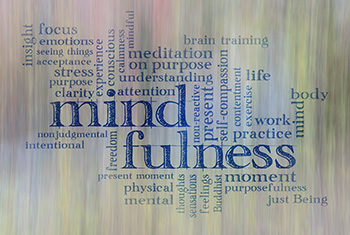The Everyday Mindfulness Model
 Robert McFadden presented an innovative lecture and workshop at the last Coaches Breakfast where we discussed shifting from BEING to DOING and focusing one’s attention for constructive change on how we are becoming through presence and mindfulness! Besides the collective meditation we shared, one of the most powerful experiences for those who attended was standing for several minutes of silence, eye to eye with a partner and then rapidly sharing things that we loved in our lives. The connections we made were quite awesome. Here is an excerpt from his book “Love Your Negative Self-Talk: Practical Ways to Turn Your Most Vicious Critic Into Your Most Valued Collaborator” (2017).
Robert McFadden presented an innovative lecture and workshop at the last Coaches Breakfast where we discussed shifting from BEING to DOING and focusing one’s attention for constructive change on how we are becoming through presence and mindfulness! Besides the collective meditation we shared, one of the most powerful experiences for those who attended was standing for several minutes of silence, eye to eye with a partner and then rapidly sharing things that we loved in our lives. The connections we made were quite awesome. Here is an excerpt from his book “Love Your Negative Self-Talk: Practical Ways to Turn Your Most Vicious Critic Into Your Most Valued Collaborator” (2017).
Perhaps you've practised mindfulness meditation? Or tried to practice it? At its simplest, mindfulness meditation involves focusing your attention on your breath. Your sole aim, for whatever period you choose, is just that. Pay attention to your breathing. “I'm breathing in ... I'm breathing out ... I'm breathing in ...”- you get the idea. Stick with that. Nothing else.
What could be more simple? And yet, how did it go for you the first time you gave it a whirl? If you've never tried it before, give it a go right now. See what happens. Simple, huh?
So, what actually happens when you sit down to do a mindfulness meditation? You sit down, comfortable and alert. You bring your full attention to your breath. “Breath in ... breath out. ...” Your breath is your point of focus. “Breath in ... breath out. ...”
At some point, your attention shifts. Perhaps it's to a thought about lunch. Maybe it's drawn to a sudden bark from your neighbour's dog. Or that itch at the tip of your nose. Long story short, you're no longer focused on your breath. Time passes. Eventually you have a moment of awareness. “Oh, look! My attention has shifted! It's no longer on my breath!”
Where is your attention? It's on that terrible pesto salad you ate yesterday. Or on Sparky and his incessant barking. Or on that itch on your nose. It's really itchy!
Now you have a choice. Do you abandon your meditation practice and continue stewing over salads, Sparkies or schnozzles? Do you continue your meditation practice and return your focus to your breath?
You choose to exercise a little act of willpower. Presto! Your focus is back on your breath.
Three elements in mindful meditation help in practising how you focus your attention. The first is having a clear, concise point of focus. In the example above, the point of focus is the breath. The second element is awareness. That moment when you notice that you attention has shifted elsewhere. The third element is that little act of willpower to return your focus back to your breath.
We can think of the meditation process as a series of little acts of willpower repeated over time. With these little acts we repeatedly make and execute the simple choice of returning to a point of focus. It's like a spark plug firing in a car engine. We're not constantly running on willpower, burning up resources and draining your energy. It's only needed for a moment to get us back on track when attention wanders. A clear point of focus provides us a target to which we direct our attention. Our little acts of willpower, together with our flash of awareness and specific point of focus, form the engine for maintaining our attention as we choose moment by moment. Mindfulness breath meditation is a wonderful practice for developing awareness of our attention. It provides opportunities for exercising those little acts of willpower. It habituates our setting a priority for focusing attention. It is also a marvellous model for how we can focus our attention in any situation, no matter where or when.
Welcome to the Everyday Mindfulness model
Consider what happens when, in place of your breath, you set a new point of focus. Essentially you're creating a new meditation. How about, in place of a breath meditation, you try a dish-washing meditation? Or a vacuuming meditation? What would that involve? Imagine a conversing-with-my-boss meditation. Or a working-on-these-math-problems meditation. What could you try out to use as your focus in each of these?
When Carla Capelli came to me for coaching, she already had some basic skills in focusing and maintaining attention. With a couple of years of informal meditation and yoga practice, Carla had a passing familiarity with a few mindfulness concepts and techniques. Her problems began once she stepped away from her mindfulness routines. When she stepped into her everyday world.
Carla's house was a disaster area. Her office was disorganized. Her relationship with her boss sucked. What was happening? We began by discussing a small challenge. Vacuuming. On housecleaning day, Carla would plug in the vacuum cleaner, turn it on, and start in the hallway. Then she'd remember the dirty dishes she'd left in the sink and turn the vacuum cleaner off.
Halfway to the kitchen she'd remember the overflowing laundry hamper. She'd adjust her course accordingly. You get the idea. Carla could spend the better part of her morning careening around her home. Almost getting things done.
I asked Carla how she could apply her meditation know-how to her housekeeping horrors. She knew in an instant. She would begin with a vacuuming meditation. Plug in the vacuum cleaner. Turn it on. Start vacuuming the hallway. She would notice when that thought about the dirty dishes showed up, let it go and return her attention to vacuuming. She would repeat this process until the vacuuming was done, then begin a dish-washing meditation. Then a laundry meditation. And, one day, an attentive-conversation-with-the-boss meditation. It would all take the same skill - just different points of focus, depending on the task at hand.

